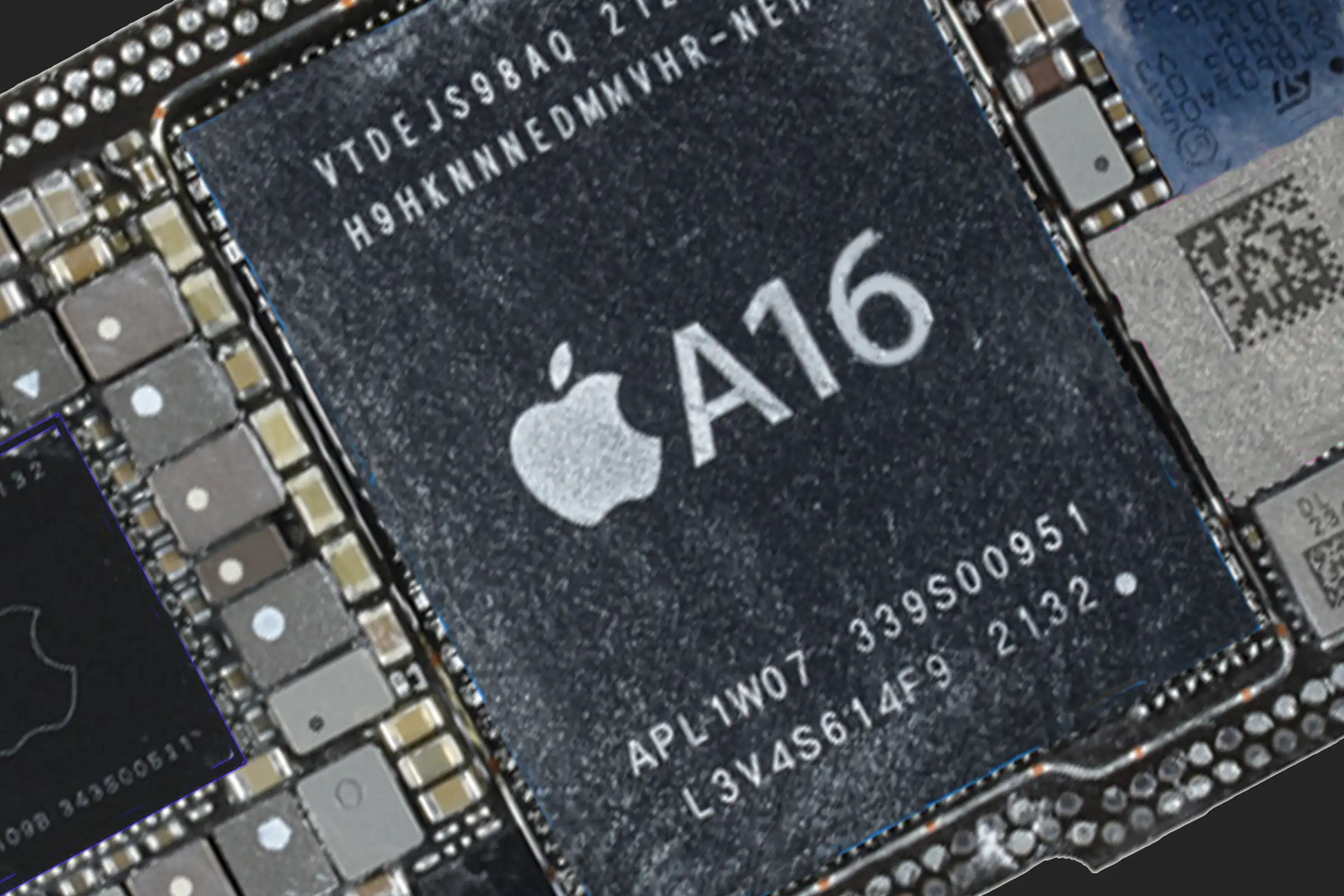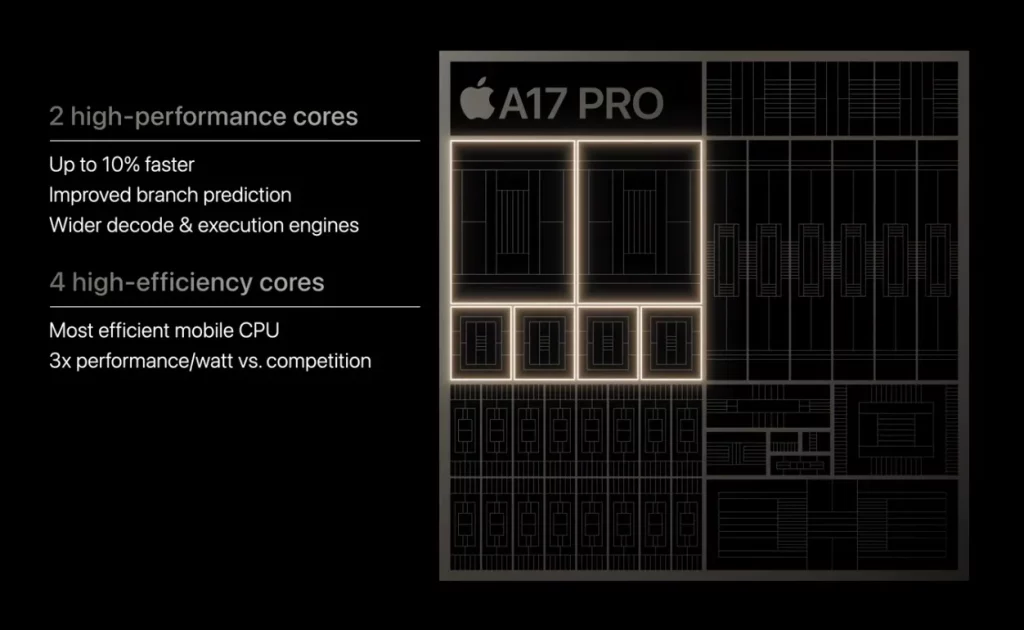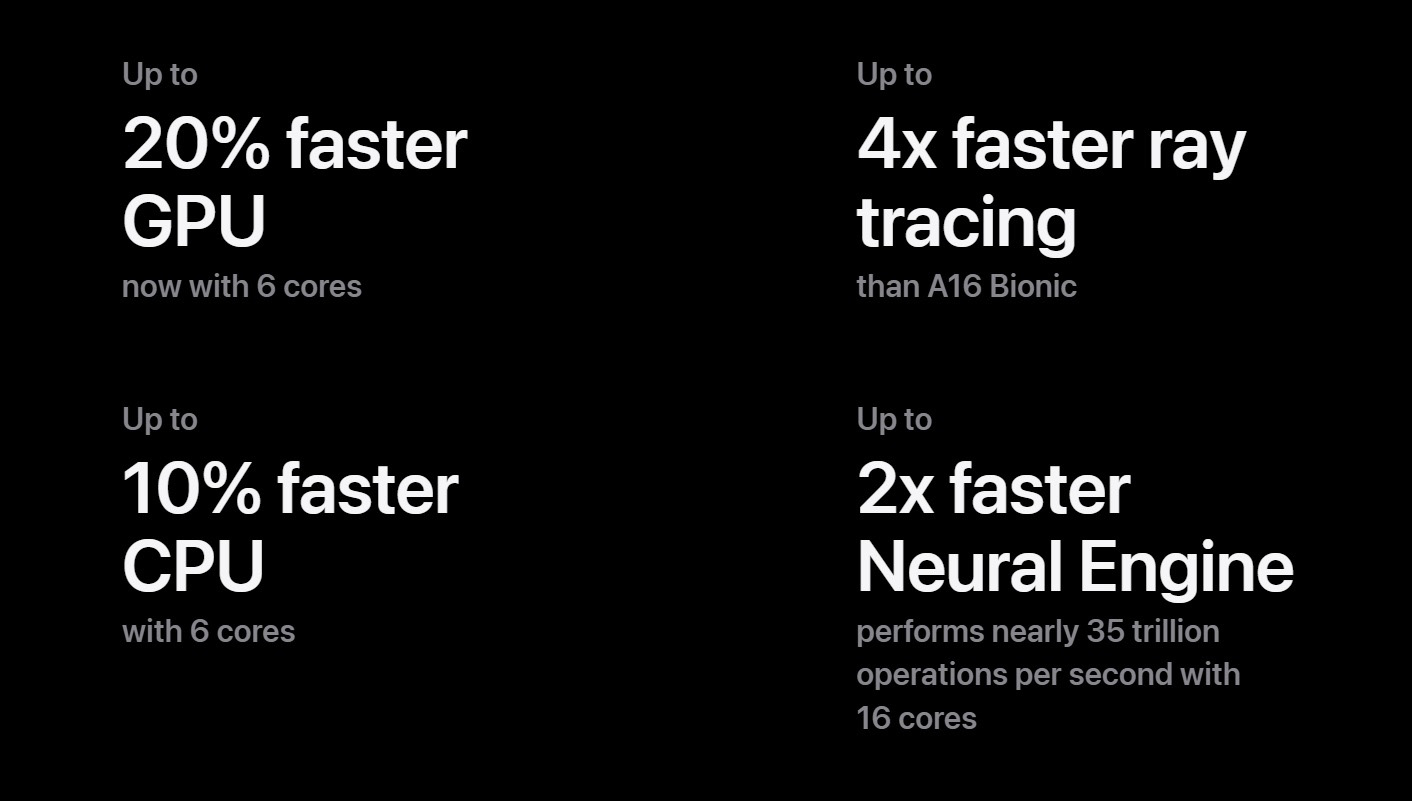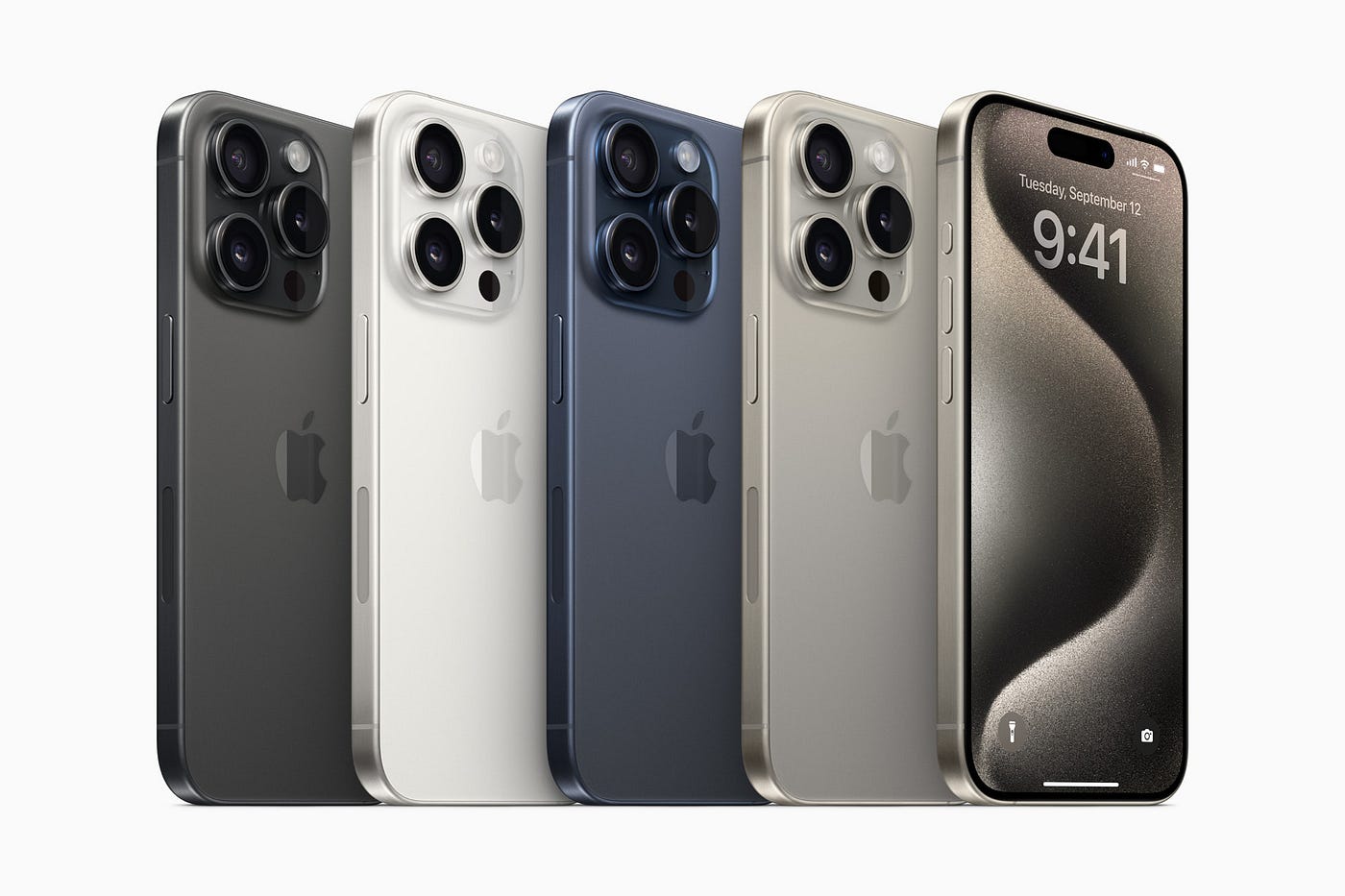Highlights
- A17 Pro’s 3nm process outshines A16’s 4nm technology, offering superior efficiency and speed.
- Enhanced AI capabilities with the A17 Pro’s 32-core Neural Engine, doubling the A16’s performance.
- A17 Pro introduces gaming revolution with hardware-accelerated ray tracing, a leap over A16.
- USB 3.2 Gen 2 support in A17 Pro drastically improves data transfer speeds compared to A16.
The Apple A17 Pro is the latest silicon marvel powering the iPhone 15 Pro and Pro Max models, marking a significant upgrade from the A16 Bionic that runs the show in the iPhone 15 and 15 Plus.
In the following comparison, we’ll dive into the subtleties of these two formidable chips, illuminating their speed, efficiency, and capabilities.
So, let’s get started on this journey of discovery into the heart of Apple’s smartphone lineup.
| Feature | A16 Bionic | A17 Pro |
| Process Technology | 4nm | 3nm |
| Transistors | 16 billion | 19 billion |
| CPU Cores | 6 (2 high-performance, 4 efficiency) | 6 (2 high-performance, 4 efficiency) |
| CPU Clock Speed | Up to 3.5 GHz | Up to 3.8 GHz |
| GPU Cores | 5 | 6 |
| Neural Engine | 16-core | 32-core |
| Memory | 6GB LPDDR5 | 8GB LPDDR5X |
| Display Support | Up to 4K 120Hz | Up to 8K 144Hz |
| Camera Processing | ProRes video capture | ProRes RAW video capture |
| Machine Learning | 17 trillion operations per second | 35 trillion operations per second |
| Geekbench 5 Score (Single-Core) | 4095 | 4510 |
| Geekbench 5 Score (Multi-Core) | 11112 | 12208 |
Chip Design and Process Technology

- A17 Pro: Represents a leap in chip technology as Apple’s first 3-nanometer (nm) chip. This smaller process size allows for more transistors (19 billion) to be packed into the same space, compared to the A16, enhancing both performance and energy efficiency.
- A16 Bionic: Utilizes a 4nm process technology with 16 billion transistors. While impressive in its own right, it falls short of the transistor density and efficiency gains offered by the 3nm process of the A17 Pro.
CPU and GPU Performance

- CPU Cores: Both chips have a 6-core CPU configuration, but the A17 Pro introduces architectural improvements that boost its single-threaded performance significantly, making it the fastest in any smartphone according to Apple.
- Benchmarking Scores: As per testing done by 9to5Mac, the A17 Pro outperforms the A16 in Geekbench results, with a 16% increase in single-core and a 13% increase in multi-core scores, indicating substantial performance improvements.
- GPU Cores: The A17 Pro expands its GPU core count to 6, up from the 5 cores in the A16, along with performance and efficiency enhancements.
- Gaming and Rendering: The A17 Pro introduces hardware-accelerated ray tracing for more realistic lighting and shadows in games, a feature that is 4x faster than the A16’s capabilities.
Neural Engine and Memory

- Neural Engine: The A17 Pro doubles the performance of its Neural Engine, capable of up to 35 trillion operations per second, compared to the A16’s 16-core Neural Engine with up to 17 trillion operations per second. This boost supports more advanced machine learning tasks and AI applications.
- Memory: An increase to 8GB RAM from the 6GB found in the A16 Bionic allows for better multitasking and smoother app performance, illustrating Apple’s focus on optimizing the interaction between its hardware and software.
Efficiency and Connectivity

- Energy Efficiency: While explicit efficiency metrics between the A17 Pro and A16 Bionic weren’t detailed by Apple, the A17 Pro’s 3nm process inherently suggests improved energy efficiency, offering better performance per watt and making it the “most efficient mobile CPU.”
- USB 3.0 Performance: A significant upgrade with the A17 Pro is the introduction of USB 3.2 Gen 2 support, enabling 10Gbps data transfer speeds through the new USB-C port on the iPhone 15 Pro models. This is a considerable jump from the A16’s 480Mbps speeds, enhancing file transfer and charging capabilities.
Multimedia Capabilities

- AV1 Decoder: The A17 Pro adds an AV1 decoder, improving video streaming efficiency and quality, a feature increasingly important as streaming services adopt AV1 for its better compression efficiency.
- ProRes and Display Engines: Both chips support dedicated ProRes codecs and display engines, but the A17 Pro’s enhancements in this area further boost video editing and playback capabilities on the iPhone.
Final Thoughts: A Paradigm Shift in Mobile Computing

The comparison between the A17 Pro and A16 Bionic chips demonstrates Apple’s commitment to pushing the boundaries of mobile technology.
The A17 Pro not only enhances the foundational elements of smartphone performance, such as CPU and GPU capabilities, but also introduces next-generation features like hardware-accelerated ray tracing and USB 3.2 Gen 2 support, setting new standards for what users can expect from their devices.
FAQs
What are the key differences between the A17 Pro and A16 Bionic chips?
The A17 Pro utilizes a groundbreaking 3nm process compared to the A16 Bionic’s 4nm, leading to a higher transistor count, faster CPU and GPU speeds, and enhanced energy efficiency.
How does the A17 Pro improve gaming and AI tasks over the A16?
With hardware-accelerated ray tracing and a 32-core Neural Engine, the A17 Pro significantly enhances gaming graphics and doubles the machine learning capabilities over the A16 Bionic.
What connectivity advancements does the A17 Pro offer over the A16 Bionic?
The A17 Pro supports USB 3.2 Gen 2, enabling up to 10Gbps data transfer speeds, a significant leap from the A16’s USB performance, thus improving charging and file transfer experiences.
Can the A17 Pro chip handle more demanding applications better than the A16?
Yes, thanks to its advanced process technology, increased RAM, and higher operation capacity, the A17 Pro is better equipped to handle demanding applications and multitasking more efficiently than the A16.
Does the A17 Pro offer any improvements in display and camera processing over the A16?
The A17 Pro supports up to 8K 144Hz displays and introduces ProRes RAW video capture, enhancing both the visual and camera capabilities beyond what the A16 Bionic offers.
What is A17 Pro vs A16 GPU performance?
The GPU with the A17 Pro gets an even bigger improvement over the A16 Bionic with a focus on 3 aspects:
Performance and efficiency
Complex applications
New rendering features
Speed
Apple labels the GPU “pro class” and says the new 6-core design offers 20% faster graphics performance than A16. And it remains efficient for extended gaming sessions thanks to features like mesh shading.
Hardware-based ray tracing
Another big change with the A17 Pro GPU is hardware-accelerated ray tracing. Apple says that offers much smoother graphics at higher frame rates. That’s 4x faster ray tracing than with A16 Bionic.
To highlight the capabilities, developers like CAPCOM say the new A17 Pro GPU has enabled console-quality games like Resident Evil 4 and Resident Evil Village to launch on iPhone (coming soon).
We don’t have any real-world tests for the A17 GPU.
What is the A16 Bionic?
The A16 Bionic is a system-on-chip introduced by Apple in September 2022 with the launch of the iPhone 14 Pro and Pro Max. Like past chips, the A16 Bionic uses 64-bit ARM-based architecture (like Apple Silicon, but unlike traditional x86 PC processors).
A system-on-chip (SoC) is an integrated circuit that includes a CPU, GPU, RAM, and other components. In 2023, Apple put the A16 Bionic into its base iPhone 15 and its Plus model, continuing the trend of using last year’s top-tier chip in this year’s non-Pro iPhone model.
The A16 features six CPU cores with two of them designed for high performance (clocked at just short of 3.5GHz) and four efficiency cores (running at just over 2GHz) for general compute tasks. These cores do most of the “thinking” on an iPhone, including handling background tasks, with the efficiency cores designed to preserve power and extend battery life.
On top of this, the A16 Bionic features five GPU cores running at just short of 1.4GHz, which handle graphics-intensive tasks including 3D gaming and visual effects like iOS transparency. There’s also Apple’s 16-core neural engine for machine learning tasks like identifying faces and objects in your Photos library. The A16 Bionic is equipped with 6GB of RAM and features 16 billion transistors.
The A16 Bionic introduced a new image signal processor (ISP) to improve computational photography abilities. This means better processing of images coming from the camera, resulting in less noise and ultimately better images.
Apple claimed that the A16 Bionic was the first 4-nanometer chip in a smartphone, a term that refers to the size of the transistors. Analysts discovered this is up for debate and that the chip was manufactured on a slightly improved 5nm process (known internally by chip manufacturer TSMC as N4P).
What is the A17 Pro?
The A17 Pro is an updated system-on-chip that first made its way into the iPhone 15 Pro and Pro Max in 2023. It too uses the same ARM-based architecture, but performance is slightly improved with its six-core CPU featuring two performance cores running at just shy of 3.8GHz and four efficiency cores hitting 2.1GHz.
The A17 Pro also ups the total RAM included on the SoC to 8GB, from 6GB last time around.
Apple also improved the GPU, adding an additional GPU core for a total of six cores with Apple claiming a 20% improvement over the A16 Bionic and support for hardware ray tracing and better shading for improved handling of realistic lighting effects in 3D applications.
Apple boosted the transistor count to 19 billion and added hardware support for AV1 decoding, a video codec that’s set to one day replace HEVC. The A17 Pro is manufactured using TSMC’s N3B process, which is considered to produce “true” 3-nanometer chips.
How Much Better is the A17 Pro?
Apple only claimed a 10% improvement in CPU speed over the A16 Bionic when introducing the A17 Pro, and according to many of the benchmarks, this happens to be the case.
Taking a look at the iPhone 15 Pro Geekbench single-core score shows an improvement from 2540 on the A16 Bionic to 2890 on the A17 Pro, while multi-core scores go from 6420 to 7159 respectively.
More impressive at the Metal scores, which measure GPU performance and corroborate Apple’s claim of 20% taking scores from 22574 on the A16 Bionic to 27074 on the A17 Pro.
Also Read: Apple A18 and M4 Chips to Feature Advanced 3nm Manufacturing For Handling Gen-AI
Also Read: Apple’s A17 Pro Chipset: Revolutionising Mobile Graphics and Performance
